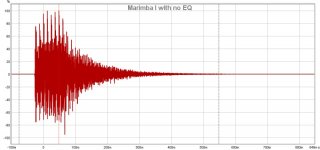The software I briefly used is "DRCDesigner". I will have to try the bag of tricks now made available in this thread  I can do the DRC either way of course, but one (lazy) reason to keep my existing EQ is because my speakers REALLY NEED EQ (they are DIY mutation of Bose 901 drivers) and also the DRC plug-in can be switched in/out without having to disable/enable the outboard EQ unit, if for no other reason than to mitigate the possibility of momentary +60 dB gain at the bass and treble 🙄 . If for no other reason, such freeware DRC solutions would be good for a nice inexpensive PC-based playback system, of course one is limited to certain players (Foobar2000 etc.) and requires the setter-upper, although not necessarily the ijit/end user, have the test equipment, set-up knowledge, etc. There is a certain perverse satisfaction in providing a taste of audio excellence to friends who are lesser mortals, and then knowing they are so befudded by technology that they'll be lucky to figure out how to play a song
I can do the DRC either way of course, but one (lazy) reason to keep my existing EQ is because my speakers REALLY NEED EQ (they are DIY mutation of Bose 901 drivers) and also the DRC plug-in can be switched in/out without having to disable/enable the outboard EQ unit, if for no other reason than to mitigate the possibility of momentary +60 dB gain at the bass and treble 🙄 . If for no other reason, such freeware DRC solutions would be good for a nice inexpensive PC-based playback system, of course one is limited to certain players (Foobar2000 etc.) and requires the setter-upper, although not necessarily the ijit/end user, have the test equipment, set-up knowledge, etc. There is a certain perverse satisfaction in providing a taste of audio excellence to friends who are lesser mortals, and then knowing they are so befudded by technology that they'll be lucky to figure out how to play a song 
 I can do the DRC either way of course, but one (lazy) reason to keep my existing EQ is because my speakers REALLY NEED EQ (they are DIY mutation of Bose 901 drivers) and also the DRC plug-in can be switched in/out without having to disable/enable the outboard EQ unit, if for no other reason than to mitigate the possibility of momentary +60 dB gain at the bass and treble 🙄 . If for no other reason, such freeware DRC solutions would be good for a nice inexpensive PC-based playback system, of course one is limited to certain players (Foobar2000 etc.) and requires the setter-upper, although not necessarily the ijit/end user, have the test equipment, set-up knowledge, etc. There is a certain perverse satisfaction in providing a taste of audio excellence to friends who are lesser mortals, and then knowing they are so befudded by technology that they'll be lucky to figure out how to play a song
I can do the DRC either way of course, but one (lazy) reason to keep my existing EQ is because my speakers REALLY NEED EQ (they are DIY mutation of Bose 901 drivers) and also the DRC plug-in can be switched in/out without having to disable/enable the outboard EQ unit, if for no other reason than to mitigate the possibility of momentary +60 dB gain at the bass and treble 🙄 . If for no other reason, such freeware DRC solutions would be good for a nice inexpensive PC-based playback system, of course one is limited to certain players (Foobar2000 etc.) and requires the setter-upper, although not necessarily the ijit/end user, have the test equipment, set-up knowledge, etc. There is a certain perverse satisfaction in providing a taste of audio excellence to friends who are lesser mortals, and then knowing they are so befudded by technology that they'll be lucky to figure out how to play a song 
Leave outboard EQ in and if you like the shape of your FR as is build at target response that resembles it. These guys can help you there.
And now for something silly!
The Schroeder frequency is fairly well known, is the transition between bass (modal) modes and the diffuse (highs) in a typical listening room. Often this is around 250 Hz.
Not as well known is the Schrödinger frequency. The theory states that you cannot know whether the room is "live" or "dead" until you measure it 🙂
The Schroeder frequency is fairly well known, is the transition between bass (modal) modes and the diffuse (highs) in a typical listening room. Often this is around 250 Hz.
Not as well known is the Schrödinger frequency. The theory states that you cannot know whether the room is "live" or "dead" until you measure it 🙂
The software I briefly used is "DRCDesigner". I will have to try the bag of tricks now made available in this threadI can do the DRC either way of course, but one (lazy) reason to keep my existing EQ is because my speakers REALLY NEED EQ (they are DIY mutation of Bose 901 drivers) and also the DRC plug-in can be switched in/out without having to disable/enable the outboard EQ unit, if for no other reason than to mitigate the possibility of momentary +60 dB gain at the bass and treble 🙄 . If for no other reason, such freeware DRC solutions would be good for a nice inexpensive PC-based playback system, of course one is limited to certain players (Foobar2000 etc.) and requires the setter-upper, although not necessarily the ijit/end user, have the test equipment, set-up knowledge, etc. There is a certain perverse satisfaction in providing a taste of audio excellence to friends who are lesser mortals, and then knowing they are so befudded by technology that they'll be lucky to figure out how to play a song

If you're really stuck on/to your EQ solution RePhase might be a good solution to do time correction. But I'm not quite sure why you cling on to the current EQ solution. I have line arrays, that really NEED EQ down low and up high and still use DRC to flatten out the FR response.
I do some gentle pré EQ to get the speakers perform in the ballpark of the DRC correction, broad EQ with low Q's. Here's what the EQ looks like in REW:

After that I let DRC sort out the frequency and time domain.
Here's the left and right channel after DRC:

Red is right, blue is left, measured at the listening position 1/12 oct. smoothing.
wesayso,
I have been considering giving this a try. I currently have a reasonable PEQ plus an FIR Phase correction filter (rePhase).
> Would you post your FIR filter responses (SPL+Phase) so we can see what they contribute to your EQ?
I am concerned about the total magnitude of the resulting EQ as some 100-400Hz dips/nulls are pretty severe in my room situation.
I have been considering giving this a try. I currently have a reasonable PEQ plus an FIR Phase correction filter (rePhase).
> Would you post your FIR filter responses (SPL+Phase) so we can see what they contribute to your EQ?
I am concerned about the total magnitude of the resulting EQ as some 100-400Hz dips/nulls are pretty severe in my room situation.
I have this example for you:

The upper most graph is my lines with EQ,
The second graph is the correction from DRC
The third is predicted response
The fourth is measured response
It's obviously from a while back but still valid.
The phase correction is done over a small window and probably not as elaborate as your RePhase corrected phase. I haven't got an immediate example at hand but it depends on several settings. Right now I'm actually correcting to minimum phase, not linear phase.

The upper most graph is my lines with EQ,
The second graph is the correction from DRC
The third is predicted response
The fourth is measured response
It's obviously from a while back but still valid.
The phase correction is done over a small window and probably not as elaborate as your RePhase corrected phase. I haven't got an immediate example at hand but it depends on several settings. Right now I'm actually correcting to minimum phase, not linear phase.
Thanks!
That shows the SPL well. The overall EQ impact will probably be significantly more aggressive in total than my current PEQ alone, but looks like it may be workable at least for a good trial. I'll see of I can follow the directions and get it working.
That shows the SPL well. The overall EQ impact will probably be significantly more aggressive in total than my current PEQ alone, but looks like it may be workable at least for a good trial. I'll see of I can follow the directions and get it working.
If not, report back. I'm sure we can get you going... as long as you have a relatively clean impulse measurement at the listening position.
Impulsive question.
Define a "clean impulse measurement." Do you mean an accurate one (my assumption)?
Here is an impulse of one channel at my listening position before any processing was done. Since I have not (yet) implemented any time correction, I haven't bothered to make a corrected measurement.
Define a "clean impulse measurement." Do you mean an accurate one (my assumption)?
Here is an impulse of one channel at my listening position before any processing was done. Since I have not (yet) implemented any time correction, I haven't bothered to make a corrected measurement.
Attachments
Define a "clean impulse measurement." Do you mean an accurate one (my assumption)?
Here is an impulse of one channel at my listening position before any processing was done. Since I have not (yet) implemented any time correction, I haven't bothered to make a corrected measurement.
Check out the guide posted by gmad on the first page, and mine, with including pictures, of what you will be looking to get.
You'll need a stereo sweep to make sure your peaks align and you are at the exact sweet spot, then Left and Right sweeps, looking at the single peak, and make sure there are no huge reflections that would interfere with the process.
Define a "clean impulse measurement." Do you mean an accurate one (my assumption)?
Here is an impulse of one channel at my listening position before any processing was done. Since I have not (yet) implemented any time correction, I haven't bothered to make a corrected measurement.
I think that a sufficiently "clean" impulse response is one in which the impulse center is the first and loudest peak in the waveform. If this is the case, REW will automatically position the impulse center at t=0. Take a look at my IR (in post #2) before and after correction. I didn't choose the most visible of colors for my graphs, but it should help to make my point if you look closely.
The measurement you posted doesn't look anything like an IR of a speaker. How did you get that result?
Do your best to follow the guide and report back with your progress.
My impulse is from REW doing a swept sine wave at listening position one speaker 20 to 20 k with no EQ., I'm guessing it is a sloppy impulse response. Probably because I am in a large oddly shaped mostly reflective room.
Sent from my pc1162 using Tapatalk
Sent from my pc1162 using Tapatalk
My impulse is from REW doing a swept sine wave at listening position one speaker 20 to 20 k with no EQ., I'm guessing it is a sloppy impulse response. Probably because I am in a large oddly shaped mostly reflective room.
Sent from my pc1162 using Tapatalk
I hope that none of my comments came across as rude; I just want to be sure that any measurements are accurate before going further. It doesn't matter how "clean" or "sloppy" an IR is, just that the measurement is performed correctly and that DRC can interpret it properly.
From what I see in your IR, DRC will need help interpreting the IR because it seems as though there are reflections that are louder than the actual impulse. Notice also that the signal begins before t=0 which means REW did not properly identify the impulse center. If you'd like, you can send me the file and I'll be happy to take a closer look for you.
I was attempting to set this up today using a new pair of sweeps with REW. I can't seem to figure how to convert REW's exported (*.WAv) format into the *.PCM that DRCDesigner wants. Cool Edit is mentioned and I have never used it. I downloaded the trial of its descendant, Adobe Audition of which I also know diddley-squat 🙂 and yes there are an amazing number of choices for save/export but the *.PCM appeareth not.
Can anyone suggest how I can convert the *.WAV so that I may proceed?
Can anyone suggest how I can convert the *.WAV so that I may proceed?
From the guide included in the initial post of this thread:
-Prepare the impulse response files for DRC
Open the impulse response wave file using Audacity. If it was determined that the impulse center of each measurment was indeed the loudest peak, split the stereo track into two separate mono tracks (choose "Split Stereo to Mono" from the track dropdown menu) and export the tracks as separate files in RAW 32 bit float format (File - Export Multiple etc...). After exporting, change the filenames and extensions to LeftSpeakerImpulseResponse.pcm and RightSpeakerImpulseResponse.pcm and place these files in the "sample" folder (located inside of the "DRC-3.2.1" folder).
If it was determined that the impulse center of either measurement was not the loudest peak of the waveform, normalize the stereo track (use the amplitude effect to make the new peak amplitude 0.0db) while making note of about how much amplification is being performed. Visually confirm the location of each impulse center (zoom in until individual samples are visible). There is a chance that the impulse centers will not be vertically aligned, and in this case, one of the tracks should be shifted forward or backwards so that the impulse centers of each channel are located at the same sample (point in time). Take note of what sample the impulse centers are now located at by positioning the cursor at the impulse centers (checking the "Snap To" checkbox will help) while the "selection start" value is set to "samples". Undo the amplification, split the track into two separate mono tracks (choose "Split Stereo to Mono" from the track dropdown menu) and export the tracks as separate files in RAW 32 bit float format (File - Export Multiple etc...). After exporting, change the filenames and extensions to LeftSpeakerImpulseResponse.pcm and RightSpeakerImpulseResponse.pcm. and place these files in the "sample" folder (located inside of the "DRC-3.2.1" folder).
-Prepare the impulse response files for DRC
Open the impulse response wave file using Audacity. If it was determined that the impulse center of each measurment was indeed the loudest peak, split the stereo track into two separate mono tracks (choose "Split Stereo to Mono" from the track dropdown menu) and export the tracks as separate files in RAW 32 bit float format (File - Export Multiple etc...). After exporting, change the filenames and extensions to LeftSpeakerImpulseResponse.pcm and RightSpeakerImpulseResponse.pcm and place these files in the "sample" folder (located inside of the "DRC-3.2.1" folder).
If it was determined that the impulse center of either measurement was not the loudest peak of the waveform, normalize the stereo track (use the amplitude effect to make the new peak amplitude 0.0db) while making note of about how much amplification is being performed. Visually confirm the location of each impulse center (zoom in until individual samples are visible). There is a chance that the impulse centers will not be vertically aligned, and in this case, one of the tracks should be shifted forward or backwards so that the impulse centers of each channel are located at the same sample (point in time). Take note of what sample the impulse centers are now located at by positioning the cursor at the impulse centers (checking the "Snap To" checkbox will help) while the "selection start" value is set to "samples". Undo the amplification, split the track into two separate mono tracks (choose "Split Stereo to Mono" from the track dropdown menu) and export the tracks as separate files in RAW 32 bit float format (File - Export Multiple etc...). After exporting, change the filenames and extensions to LeftSpeakerImpulseResponse.pcm and RightSpeakerImpulseResponse.pcm. and place these files in the "sample" folder (located inside of the "DRC-3.2.1" folder).
Since the pcm file we need is really a raw file, it's just a matter of changing the extension.
How does the new IR look?
How does the new IR look?
Thanks to gmad for the guide and also to wesayso for the constructive comments and encouragement. I had been holding off experimenting with DRC as I found the process and documentation very confusing. This thread has really helped get me started.
I have run my first trial successfully after working through several issues with file formats. The measurements look good and I intend to do some more experimentation.
The following is of my current setup using PEQ with Phase correction on top Vs. the current PEQ with DRC on top. That is, my rePhase phase correction filter was replaced with the DRC filter. The objective here was just to get rational result. Now I can work toward finding settings that advance the sound quality. I have several ideas in mind.
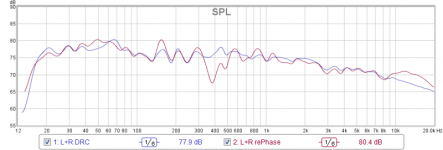
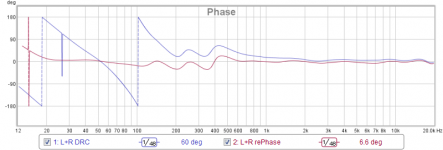
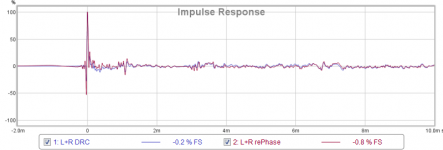
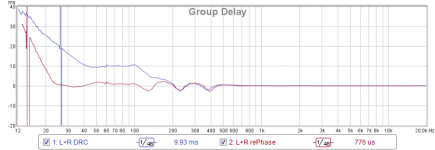
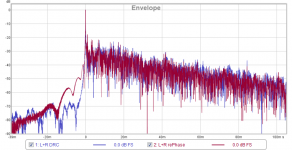
I have run my first trial successfully after working through several issues with file formats. The measurements look good and I intend to do some more experimentation.
The following is of my current setup using PEQ with Phase correction on top Vs. the current PEQ with DRC on top. That is, my rePhase phase correction filter was replaced with the DRC filter. The objective here was just to get rational result. Now I can work toward finding settings that advance the sound quality. I have several ideas in mind.





Good to see the comparison. I was expecting something like this. With RePhase you have corrected the phase way down to 20 Hz. DRC will not correct all the way down with a relative short window like in the 4 cycle template.
But DRC does have a slightly better FR response correction. Nice room by the way. What kind of room/speakers are we talking about?
What are your initial thoughts about the perceived differences? Could you show the STEP as well from both RePhase and DRC?
But DRC does have a slightly better FR response correction. Nice room by the way. What kind of room/speakers are we talking about?
What are your initial thoughts about the perceived differences? Could you show the STEP as well from both RePhase and DRC?
This is a 5-cycle run using both a house curve and mic cal. My room/setup is actually very poor from 100-600Hz with lots of phase difference between L and R channels due to room effects. This causes L and R dips in this range to become much larger when using L+R mono signal. There is little that any EQ can do in this area as room acoustics prevail for the direct sound. These dips can only be reduced with significant boost such that the late arriving SPL (~20ms delay) is great enough that it fills the dip. The debate seems to be; "is it better sounding to allow the large dips or fill them with late arriving SPL?" That is part of my investigations. Currently I am at a partial fill and limit the PEQ boost to 5dB.
The SR charts are shown below. If you have any idea why the SR and GD of the DRC appears to be discontinuous let me know. The DRC filter appears to have actually delayed/shifted the bass by 10ms between 100>200Hz. Is it your experience with these particular settings? I would have preferred to see the GD rollup more smoothly starting at 200Hz. I think this would have improved the appearance of the SR.
Also attached is the L and R preamp output measurement showing the impact of the DRC filter by itself.
My short comments regarding sound quality follow, but are not too meaningful as my hearing is substandard. Both setups are very good, but they do sound a little different to me. My first impression was that the DRC may have been a little better >1kHz. The reduction of the large dip around 400Hz may also have helped the tonal balance. The problem is that, I saw the measurements prior to the listening so that may have contributed to this impression. In any case these are very subtle differences for me.
Obviously, I need to eliminate (or at least limit my PEQ to overall shaping) and let DRC do the entire EQ. This will be a better comparison regarding music sound quality. I will do that at some point. It will probably not be a normal setup for me however since I also use the setup for 5.1 theater. That is the reason I am motivated to retain at least much of the current PEQ.
Just to be clear, I think DRC is a good freeware option for room EQ. It's likely to make very significant improvement in challanging rooms and add some modest improvement to good rooms.
Sorry for the ramble. Any thoughts, commments or opinions are welcome.
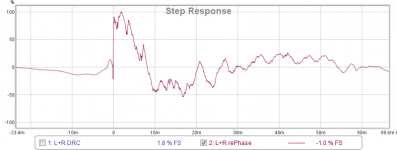
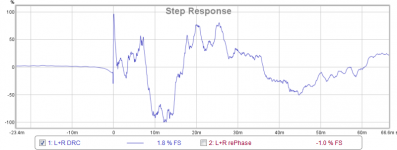

The SR charts are shown below. If you have any idea why the SR and GD of the DRC appears to be discontinuous let me know. The DRC filter appears to have actually delayed/shifted the bass by 10ms between 100>200Hz. Is it your experience with these particular settings? I would have preferred to see the GD rollup more smoothly starting at 200Hz. I think this would have improved the appearance of the SR.
Also attached is the L and R preamp output measurement showing the impact of the DRC filter by itself.
My short comments regarding sound quality follow, but are not too meaningful as my hearing is substandard. Both setups are very good, but they do sound a little different to me. My first impression was that the DRC may have been a little better >1kHz. The reduction of the large dip around 400Hz may also have helped the tonal balance. The problem is that, I saw the measurements prior to the listening so that may have contributed to this impression. In any case these are very subtle differences for me.
Obviously, I need to eliminate (or at least limit my PEQ to overall shaping) and let DRC do the entire EQ. This will be a better comparison regarding music sound quality. I will do that at some point. It will probably not be a normal setup for me however since I also use the setup for 5.1 theater. That is the reason I am motivated to retain at least much of the current PEQ.
Just to be clear, I think DRC is a good freeware option for room EQ. It's likely to make very significant improvement in challanging rooms and add some modest improvement to good rooms.
Sorry for the ramble. Any thoughts, commments or opinions are welcome.



- Home
- Loudspeakers
- Full Range
- A convolution based alternative to electrical loudspeaker correction networks
